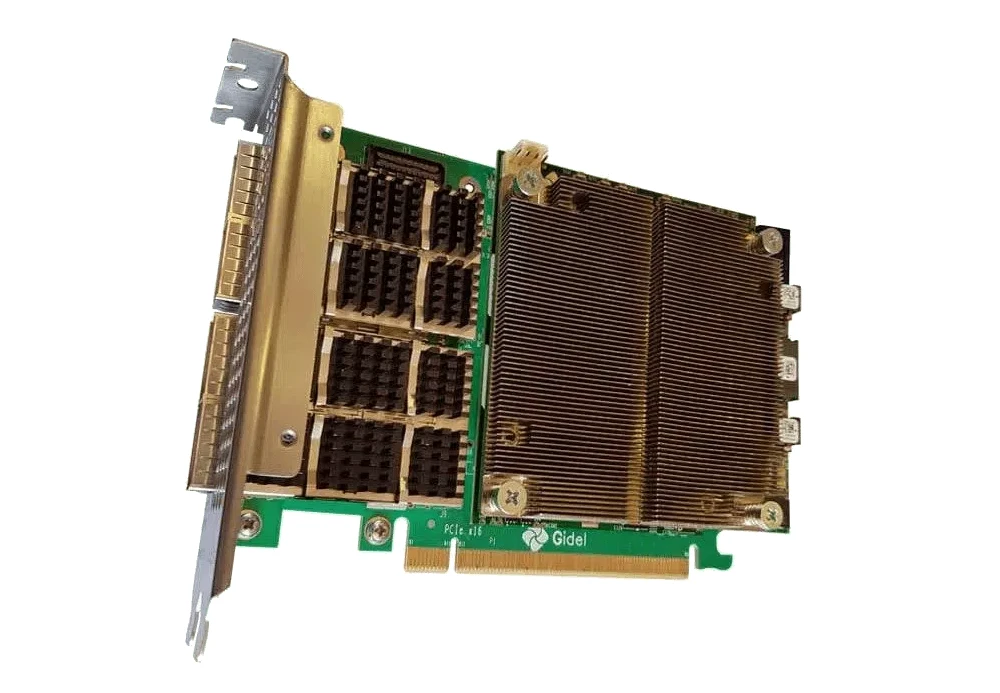

This powerful Gidel FPGA-based GigE frame grabber is offered in two configurations. By combining Gidel’s powerful Proc1C10M carrier board & Proc10M FPGA module, or the Proc1C10N carrier board & Proc10N FPGA module, this FPGA-based frame grabber delivers exceptional processing capabilities, system compactness, and cost-effectiveness.
At its core, the Proc10M / Proc10N module leverages the Intel® Stratix® 10 MX FPGA, which provides 10 times the DRAM and SRAM bandwidth compared to discrete DDR4 and QDR memories. This design makes the advanced technology readily accessible for computer-based, embedded systems, and Edge Computing applications.
The off-the-shelf Proc1C10M / Proc1C10N carrier board further enhances this solution by offering a PCIe Gen.3 x16 host interface, four QSFP28 ports for up to 400 Gb/s aggregated bandwidth, a Gidel PHS connector for daughterboard mounting, and 19 GPIOs for peripheral system control.
Gidel FPGA frame grabbers offer real-time, high-bandwidth vision and image processing. Their frame grabbers range from economical off-the-shelf frame grabbers to high-performance, multi-camera custom solutions with 10GigE or CoaXPress interfaces. Development is streamlined with the ProcFG and InfiniVision SDK, which includes GUIs, APIs, and libraries with support for complex multi-camera setups, advanced image processing, and compression.
Contact us to learn more about the Gidel’s frame grabber options, and whether a ready-to-use, standard, or customized frame grabber is best for your application.
 Proc10M Module Datasheet
Proc10M Module Datasheet
 Proc10N Module Datasheet
Proc10N Module Datasheet
 Proc1C Carrier Board Datasheet
Proc1C Carrier Board Datasheet
| Camera Interface | 4x QSFP28 for 16 x 26 Gb/s enabling up to 4 x 100 GigE |
| FPGA processing | Stratix 10MX 2100 HBM2 FPGA: 2,073,000 LEs 7,920 18 x19 MAC |
| Advanced Features | Link Aggregation mode Chunk Data Selective ROI acquisition Option for on-FPGA compression |
| Image Formats | Mono, Bayer, RGBA (8, 10, 12, 14 and 16 bits/color) and RGB (8, 10 and 12 bits/ color) |
| Max. Resolution |
Horizontal: 16 K pixels (64-bit) Vertical: 65 K lines |
| Acquisition Rate | Up to 400 Gb/s |
| Host Bus | PCIe Gen. 3 x 16 19 x GPIOs Gidel PHS connector for daughterboards |
| Camera Types | Area and Line Scan |
| Form Factor | PCIe half-length |
| Connectors | QSFP+ and 2 x SFP+ |
| GPIO | 19 x GPIOs |
| Grabber architecture type |
The Gidel Frame Grabber boards can operate in one of two unique Frame Grabber architectures, ProcFG or InfiniVision, by reprogramming the firmware. Grabber option #1: InfiniVision
Grabber option #2: ProcFG
|
| Camera interface connector | SFP+ | RJ45 |
| FPGA Option | Optional on-FPGA processing using Gidel's libraries (IPs), Gidel's tailored library functions (IPs), or user customized IPs |
| Carrier board | Option for user or Gidel custom carrier board. For customization please, contact us |
Contact us if you need a customized solution!
SDK: The ProcFG and InfiniVision are each supported by their unique GUI and API suite for developing user applications.
FPGA Programming Suite: The Gidel grabber boards are supported by the ProcVision Suite enabling tailoring, debugging, and verification of the FPGA image processing and data flow.
Customization can be based on the InfiniVision or ProcFG flow, and can include multi-instances for supporting unique multi-camera topologies, as well as, image processing and compression.